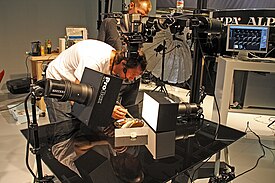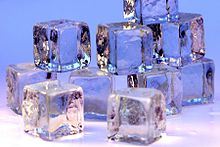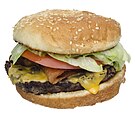
Food photography is a still life photography genre used to create appealing still life photographs of food. As a specialization of commercial photography, its output is used in advertisements, magazines, packaging, menus or cookbooks. Professional food photography is a collaborative effort, usually involving an art director, a photographer, a food stylist, a prop stylist and their assistants. With the advent of social media, amateur food photography has gained popularity among restaurant diners.
In advertising, food photography is often – and sometimes controversially – used to exaggerate the attractiveness or size of the advertised food, notably fast food.
History

The first known photograph that showed food as a subject was a 1845 daguerreotype by William Henry Fox Talbot showing peaches and a pineapple.
For a long time, food photographs tended to be shot and composed in a manner similar to the way people were used to encountering their food: laid out on a table setting and shot from an overhead perspective, i.e., from the point of view of the eater. Stylists accordingly arranged the food to appear good from above, with the items arranged flat on the plate and clearly separated from each other.
Later, romantic lighting, shallower angles and more props came en vogue, with extreme cases leading to the term "food porn". Most recently, the prevailing trend in Western commercial food photography is to present the food as simple, clean and naturally as possible and with little props, often using effects such as selective focus, tilted plates, and extreme close-ups. This complements trends in professional cooking to make the food more visually interesting. For instance, the height of dishes tends to increase and their elements are often layered, which lends itself well to narrow-angled shots.
As a professional practice
Food stylist

The role of the food stylist is to make the food look attractive in the finished photograph. The time and effort a stylist takes to carefully and artfully arrange the food is due to differences between the way the stylist presents it and the way a home cook or chef may. Visual know-how is also a requirement, as is the knowledge of how to translate the perception of taste, aroma and appeal that one gets from an actual dish to a two-dimensional photograph.
Food stylists have culinary training; some are professional chefs or have a background in home economics. In addition to knowledge of nutrition and cooking techniques, food stylists must also be resourceful shoppers. As creative professionals they envision the finished photograph and style the food accordingly.
Setup
The process of food photography begins with the purchase of the food and ingredients. Only the most visually perfect foodstuffs are acceptable and multiple backup or test items are usually needed. As a result, purchase of the food and ingredients is a very time-consuming process. The best-looking of the purchased items is selected and marked as the "hero", i.e., the item that will be featured in the photograph. During the setup and for test shoots, it is represented by a cardboard or lower-quality food item stand-in.
The actual photography can take place in a studio under controlled lighting conditions, or under natural light. The light, background and setting is carefully prepared so as to present the food in as attractive a way as possible without distracting from it. The color and texture of the background is selected so as to effectively complement that of the food and to assist with its lighting.
Styled food is usually marked as inedible and discarded after the shoot, because it may have been handled or treated in ways that make it unsafe for consumption.
- Examples of food photography
-
 A still life photograph of Kiwifruit against a white background
A still life photograph of Kiwifruit against a white background
-
 A close-up of tomatoes with selective focus and a shallow angle
A close-up of tomatoes with selective focus and a shallow angle
-
 A shallow depth of field creates a defocused effect to highlight a food product
A shallow depth of field creates a defocused effect to highlight a food product
- A video montage for use in a pizza commercial
Cold beverages
To create the effect of a thin layer of condensation forming on the outside of glasses containing cold liquid, dulling spray may be applied, with paper or masking tape protecting the non-"frosted" areas. More pronounced condensation and dew drops are imitated by spraying the glass with corn syrup or glycerin.

Ice cubes used in shoots are made of acrylic, so they do not move or melt during the shoot, which may take place under hot studio lighting. Prior to the widespread availability of acrylic cubes starting in the 1970s and 1980s, glass ice cubes served the same purpose. Fresh-looking bubbles on the surface of drinks are created by applying a mixture of the drink and detergent to the surface with an eyedropper. White glue may be used in lieu of milk, and a mixture of brewed coffee and water instead of tea.
Salads
Salads in food photography are composed with a view to creating appealing textures, shapes and colors. To improve support and aid in composition, salad in a bowl is built around a smaller bowl placed inverted in the larger bowl. Salad greens are kept fresh and crisp by misting them with cold water prior to composition. Salad dressing is not normally used, as it makes the salad slippery and difficult to style, but the appearance of dressing may be created by sprinkling herbs and spices over the wet salad, or mixing them in oil and applying it with a brush.
Fruit salads are particularly challenging to shoot because of the short time the fruit pieces, which are cut immediately prior to final photography, retain their appearance. As only the outer layer of the salad is of interest, the concealed interior of the salad bowl may be filled by mashed potatoes or another mixture. Thick or heavy dressings do not photograph well; they are usually thinned and applied by brush.
Hamburgers and sandwiches

 The crushed appearance of the buns and uneven toppings in the hamburger on the left make it less visually appealing. Using undamaged buns, carefully arranged toppings and soft lighting improves the presentation.
The crushed appearance of the buns and uneven toppings in the hamburger on the left make it less visually appealing. Using undamaged buns, carefully arranged toppings and soft lighting improves the presentation.
Hamburger photography is challenging because the buns dent easily and an assembled burger is quick to lose its visual appeal. When assembling the burger, the ingredients are held in place with toothpicks and the meaty interior of tomato slices is removed to avoid juice discoloring the ingredients. The meat patties are superficially cooked, the edges browned with a torch and the meat made to look more appetizing with a colorant. The edges of melted cheese slices may be brushed with household cleaner to make them look freshly melted longer. Condiments such as mayonnaise are applied to the edges with an applicator bottle. Steam is normally used to suggest the burger is hot.
Sandwiches are assembled using similar techniques. Wet paper towels are used to prevent the bread from drying out. If a half sandwich is to be depicted, the bread and the components are individually sliced with scissors and assembled in place.
Photographic portrayal of fast food has been subject to legal challenges for false advertising. Class-action lawsuit have been brought against fast-food chains McDonald's, Wendy's and Taco Bell on grounds of unfair and deceptive trade practices, alleging that photographs in marketing material depict food products larger than the items served to customers in real life. A similar lawsuit has also been proposed in 2023 against Burger King, alleging that the company's photography depicts their Whopper burger as 35% larger than in real life, with ingredients that "overflow over the bun".
As a social media phenomenon
Main article: Food photography on social media
Amateur food photography has increased with the rise of social media and the use of selfies. A popular trend has developed for diners to photograph their meals in restaurants using a mobile phone, for the purpose of sharing on sites such as Instagram or for food blogging. The practice is sometimes referred to as "camera eats first".
Influencers may use food photography to advocate healthy eating, fad diets or to promote a restaurant business. Some restaurateurs have objected to the practice and prohibit diners from taking photographs of their meals.
See also
Portals:Notes
- Manna/Moss, Chapter 4.
- Bhasin, Kim (10 January 2012). "Look At The Shocking Difference Between Fast Food Ads And Real Menu Items". businessinsider.com. Retrieved 16 April 2013.
- Cain, Abigail (17 July 2017). "Food Photography Didn't Start on Instagram—Here's Its 170-Year History". Artsy. Archived from the original on 13 November 2017. Retrieved 19 August 2020.
- ^ Manna/Moss, Introduction.
- ^ Manna/Boss, Chapter 4, section "Food-Styling Trends".
- ^ Manna/Boss, Chapter 4, section "What Is a Food Stylist?".
- Bellingham/Bybee, 6.
- Bellingham/Bybee, 8.
- Bellingham/Bybee, 4.
- Yi Chen (11 May 2010). "10 Food Photography Tips to Make It Look Tasty". photoble.com. Retrieved 16 April 2013.
- Bellingham/Bybee, 18.
- Bellingham/Bybee, 3 and 11.
- ^ Bellingham/Bybee, 29.
- Bellingham/Bybee, 33.
- Bellingham/Bybee, 36.
- Bellingham/Bybee, 41.
- Bellingham/Bybee, 42.
- Bellingham/Bybee, 60.
- Bellingham/Bybee, 61.
- Bellingham/Bybee, 62.
- Bellingham/Bybee, 65.
- Bellingham/Bybee, 68.
- Bellingham/Bybee, 69.
- Bellingham/Bybee, 88.
- Bellingham/Bybee, 93.
- Bellingham/Bybee, 95.
- Bellingham/Bybee, 98.
- Bellingham/Bybee, 100.
- Bellingham/Bybee, 108.
- "McDonald's and Wendy's sued for burger ads that mislead on size". BBC News. 18 May 2022. Archived from the original on 21 June 2022.
- Stevens, Ellie (1 August 2023). "Beef over beef: Taco Bell is accused of false advertising and allegedly skimping on fillings | CNN Business". CNN. Archived from the original on 1 August 2023. Retrieved 30 August 2023.
- "Burger King faces legal claim over size of Whopper". BBC News. 30 August 2023. Archived from the original on 30 August 2023. Retrieved 30 August 2023.
- Yong, Joceline Y. Y.; Tong, Eddie M. W.; Liu, Jean C. J. (1 November 2020). "When the camera eats first: Exploring how meal-time cell phone photography affects eating behaviours". Appetite. 154: 104787. doi:10.1016/j.appet.2020.104787. ISSN 0195-6663. PMID 32579971. S2CID 219958325. Retrieved 18 July 2023.
- Brown, Jessica. "How food influencers affect what we eat". www.bbc.com. BBC. Archived from the original on 2 May 2023. Retrieved 18 July 2023.
- Markwell, Lisa (1 August 2017). "Unicorn lollies and six million avocados: our insatiable appetite for Instafood". The Guardian. Archived from the original on 1 August 2017. Retrieved 18 July 2023.
- Rousseau, Signe (16 June 2012). Food and Social Media: You Are What You Tweet. Rowman Altamira. p. 31. ISBN 978-0-7591-2044-0. Retrieved 18 July 2023.
- "NYC restaurants ban flash photography, influencers furious". 11 April 2023. Archived from the original on 12 April 2023. Retrieved 18 July 2023.
- Clay, Xanthe (19 February 2014). "Is it wrong to photograph your food in restaurants?". www.telegraph.co.uk. Archived from the original on 20 February 2014. Retrieved 18 July 2023.
References
- Bellingham, Linda; Bybee, Jean Ann (2008). Food styling for photographers: a guide to creating your own appetizing art. Oxford: Focal Press. ISBN 978-0-240-81006-5.
- Manna, Lou; Moss, Bill (2005). Digital Food Photography. Course Technology. ISBN 1-59200-820-8.
Further reading
- McAlpine, Margaret (July 2005). Working in the Food Industry. Gareth Stevens. pp. 36–43. ISBN 978-0-8368-4776-5.